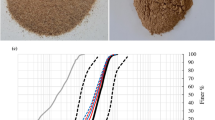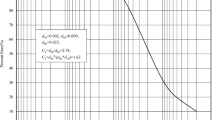Abstract
Microstructural transformation is known substantially to be the reason for the differences in mechanical behavior and the failure mechanism of saline soil. The mechanical strength of frozen saline soil decreases by 19.0% initially and then increases by 49.3% with the increasing mass content of sodium sulfate, with the threshold value of 1.5%. To explain the mechanism of this phenomenon, mercury intrusion porosity and scanning electron microscope were adopted to obtain the pore size distributions and microstructural characteristics of silty clay with different mass contents of sodium sulfate at 0.0, 1.5, 2.5 and 5.0%, respectively. The microstructural parameters were calculated by the Image-Pro Plus software based on the threshold of 75 and magnification of 1000× and 2000×. The porosity increases firstly and reduces with the rising salt content, and the fractal dimension is affected slightly ranging from 1.18 to 1.23. As the salt content increases from 0.0 to 1.5%, salts dissolve completely and the thickness of liquid film increases, so does the pore volume, and the friction of soil particles and the mechanical strength decreases. When the salt content is beyond the threshold value, the solution in soil is supersaturated, and salts crystallize and fill the pores and deduce the pore volume. The increasing interlocking abilities between crystals and particles enhance the mechanical strength of frozen saline soil. The results can provide a theoretical guidance to predict the frost and salt heave of frozen saline soil engineering.














Similar content being viewed by others
References
Agudo ER, Mees F, Jacobs P (2007) The role of saline solution properties on porous limestone salt weathering by magnesium and sodium sulfates. Environ Geol 52:269–281
Cheng GD, Jiang H, Wang KL et al (2003) Thawing index and freezing index on the embankment surface in permafrost regions. J Glaciol Geocryol 25(6):603–607
Correns VCW, Steinborn W (1939) Experimente zur Messung und Erklärung der sogenannten Kristallisationskraft. Zeitschrift für Kristallographie-Crystalline Materials A 101:117–133
Derluyn H (2014) Deformation and damage due to drying-induced salt crystallization in porous limestone. J Mech Phys Solids 63:242–255
Diamond S (2000) Mercury porosimetry-an inappropriate method for the measurement of pore size distributions in cement-based materials. Cem Concr Res 30:1517–1525
Flatt RJ (2002) Salt damage in porous materials how high supersaturations are generated. J Cryst Growth 242:435–454
GB/T 50123-1999 (1999) Standard for soil test method. People’s Republic of China National Standard. China Planning Press, Beijing: 90, 99
Jha AK, Sivapullaiah PV (2016) Volume change behavior of lime treated gypseous soil-influence of mineralogy and microstructure. Appl Clay Sci 119:202–212
Kaufmann J, Loser R, Leemann A (2009) Analysis of cement-bonded materials by multi-cycle mercury intrusion and nitrogen sorption. J Colloid Interface Sci 336:730–737
Koniorczyk M (2012) Salt transport and crystallization in non-isothermal, partially saturated porous materials considering ions interaction model. Int J Heat Mass Transf 55:665–679
Koniorczyk M (2015a) Coupled heat and water transport in deformable porous materials considering phase change kinetics. Int J Heat Mass Transf 81:260–271
Koniorczyk M (2015b) Modeling evolution of frost damage in fully saturated porous materials exposed to variable hygro-thermal conditions. Comput Methods Appl Mech Eng 297:38–61
Koniorczyk M, Gawin D (2012) Modelling of salt crystallization in building materials with microstructure-poromechanical approach. Constr Build Mater 36:860–873
Koniorczyk M, Konca P (2013) Experimental and numerical investigation of sodium sulphate crystallization in porous materials. Heat Mass Transf 49:437–449
Lai YM, Liao MK, Hu K (2016) A constitutive model of frozen saline sandy soil based on energy dissipation theory. Int J Plast 78:84–113
Liao MK, Lai YM, Yang JJ et al (2015) Experimental study and statistical theory of creep behavior of warm frozen silt. KSCE J Civ Eng. doi:10.1007/s12205-015-0374-4
Niu FJ, Cheng GD, Li JJ et al (2006) Experimental study on the thermal boundary conditions and temperature fields of duct-ventilated embankment in permafrost regions. J Glaciol Geocryol 28(3):380–389
Okorafor OC (1999) Solubility and density isotherms for sodium sulfate-water-methanol system. J Chem Eng Data 44:488–490
Romero E, Simms PH (2008) Microstructure investigation in unsaturated soils: a review with special attention to contribution of mercury intrusion porosimetry and environmental scanning electron microscopy. Geotech Geol Eng 26:705–727
Sasanian S, Newson TA (2013) Use of mercury intrusion porosimetry for microstructural investigation of reconstituted clays at high water contents. Eng Geol 158:15–22
Scherer GW (1999) Crystallization in pores. Cem Concr Res 29:1347–1358
Scherer GW (2004) Stress from crystallization of salt. Cem Concr Res 34:1613–1624
Tang CS, Shi B, Liu C et al (2008a) Influencing factors of geometrical structure of surface shrinkage cracks in clayey soils. Eng Geol 101:204–217
Tang CS, Shi B, Wang BJ (2008b) Factors affecting analysis of soil microstructure using SEM. Chin J Geotech Eng 30(4):560–565
Thaulow N, Sahu S (2004) Mechanism of concrete deterioration due to salt crystallization. Mater Charact 53:123–127
Tovey NK, Smart P, Hounslow MW et al (1992) Automatic orientation mapping of some types of soil fabric. Geoderma 53:179–200
Tsui N, Flatt RJ, Scherer GW (2003) Crystallization damage by sodium sulfate. J Cult Herit 4:109–115
Vallejo LE (1996) Fractal analysis of the fabric changes in a consolidating clay. Eng Geol 43:281–290
Wan XS, Lai YM, Wang C (2015) Experimental study on the freezing temperatures of saline silty soils. Permafr Periglac Process 26:175–187
Washburn EW (1921) Note on a method of determining the distribution of pore sizes in a porous material. Proc Natl Acad Sci USA 7:115–116
Zhou J, Ye G, Breugel KV (2010) Characterization of pore structure in cement-based materials using pressurization-depressurization cycling mercury intrusion porosimetry (PDC-MIP). Cem Concr Res 40:1120–1128
Acknowledgements
The authors greatly appreciate the two anonymous reviewers for their constructive comments and suggestions. This research was supported by National Natural Science Foundation of China (41230630, 41471063, 41601074), Key Research Projects of the Frontier Sciences of Chinese Academy of Sciences (QYZDY-SSW-DQC015), the Foundation for Excellent Youth Scholars of Cold and Arid Regions Environmental and Engineering Research Institute, Chinese Academy of Sciences (Y451231001) and the 100-Talent Program of the Chinese Academy of Sciences (Granted to Dr. Mingyi Zhang).
Author information
Authors and Affiliations
Corresponding author
Rights and permissions
About this article
Cite this article
You, Z., Lai, Y., Zhang, M. et al. Quantitative analysis for the effect of microstructure on the mechanical strength of frozen silty clay with different contents of sodium sulfate. Environ Earth Sci 76, 143 (2017). https://doi.org/10.1007/s12665-017-6454-7
Received:
Accepted:
Published:
DOI: https://doi.org/10.1007/s12665-017-6454-7




